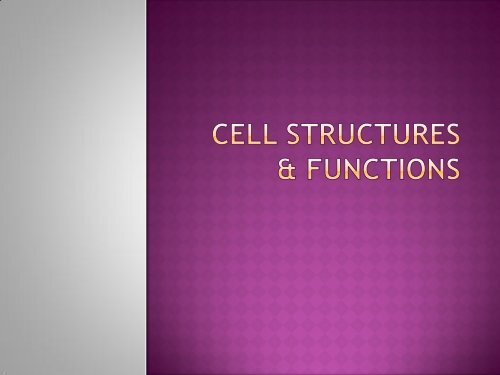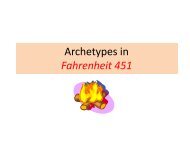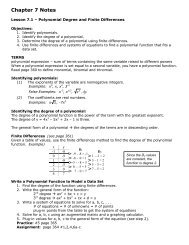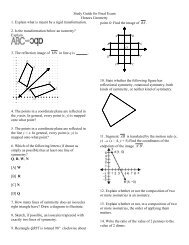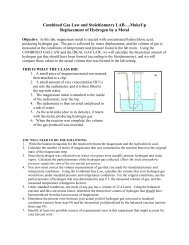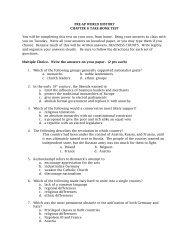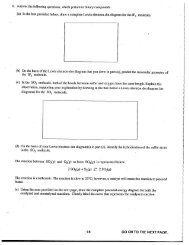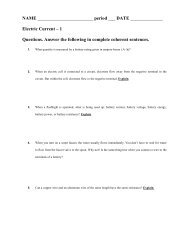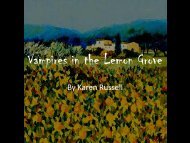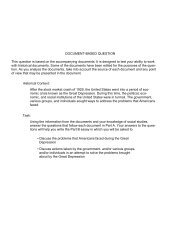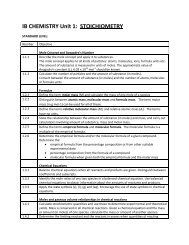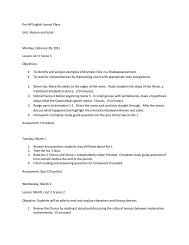Ch. 7 Cell Organelles, Structure and Function
Ch. 7 Cell Organelles, Structure and Function
Ch. 7 Cell Organelles, Structure and Function
You also want an ePaper? Increase the reach of your titles
YUMPU automatically turns print PDFs into web optimized ePapers that Google loves.
The first cells [“pro”]<br />
No membrane bound organelles
The first true [“eu”] cells<br />
Contains membrane-bound organelles
All living things are made of cells.<br />
<strong>Cell</strong>s are the basic units of structure <strong>and</strong><br />
function in living things.<br />
New cells are produced from existing cells.
Means “little organs”<br />
Membrane-bound structures inside a cell that<br />
perform a specific function.<br />
You can practice identifying organelles <strong>and</strong> functions at:<br />
http://www.cellsalive.com/cells/cell_model.htm<br />
NO organelles<br />
organelles
<strong>Cell</strong> type/Location: all cells/surrounds the cell.<br />
<strong>Structure</strong>: semipermeable lipid bilayer; proteins<br />
embedded into membrane<br />
<strong>Function</strong>: cell identification (proteins), monitors<br />
what goes in <strong>and</strong> out of cells to help MAINTAIN<br />
HOMEOSTASIS
<strong>Cell</strong> Type/Location: only<br />
plant, fungi & bacteria –<br />
surrounds the plasma<br />
membrane<br />
<strong>Structure</strong>: plants: cellulose,<br />
bacteria: petidoglycan,<br />
fungi: chitin<br />
<strong>Function</strong>: structure &<br />
support.<br />
(allows plants the structure to<br />
grow up towards the sun.)<br />
<strong>Cell</strong> wall<br />
(transparent)
<strong>Cell</strong> Type/Location: only eukaryotes/center of the<br />
cell<br />
<strong>Structure</strong>: surrounded by a nuclear envelope.<br />
Things pass in <strong>and</strong> out through nuclear pores<br />
<strong>Function</strong>: controls most cell processes & contains<br />
the hereditary info in the form of DNA
<strong>Cell</strong> Type/Location: only eukaryotes/inside nucleus<br />
<strong>Structure</strong>: small, dense region inside nucleus<br />
<strong>Function</strong>: assembles ribosomes<br />
Nucleolus
Location: inside nucleus<br />
<strong>Structure</strong>: DNA is coiled around proteins <strong>and</strong> is in a<br />
“relaxed” state. <strong>Ch</strong>romatin will condense into<br />
chromosomes right before cell division occurs.<br />
<strong>Function</strong>: holds instructions for making proteins.
Location: throughout cytoplasm. In eukaryotes, it is<br />
“free” <strong>and</strong> attached to endoplasmic reticulum.<br />
<strong>Structure</strong>: made of “ribosomal RNA” & proteins. Is NOT a<br />
membrane-bound organelle.<br />
<strong>Function</strong>: proteins are assembled at ribosomes.<br />
Ribosomes on ER make proteins for cell membrane or<br />
export. “Free” ribosomes make other cellular proteins.
Location: Fluid-like matrix that fills the inside<br />
of the cell. Includes EVERYTHING (organelles &<br />
“jelly”) except the membrane <strong>and</strong> the nucleus.<br />
3 functions are performed here: food is<br />
converted into energy, energy is stored,<br />
substances are manufactured.
Location: cytoplasm<br />
<strong>Structure</strong>: system of highly folded membranes.<br />
ROUGH ER function: modifies proteins made in<br />
the ribosomes.<br />
SMOOTH ER function: assembles lipid<br />
components of the cell membrane. Can be<br />
involved in detox of drugs. (liver cells often<br />
contain lots of smooth ER)
Location: cytoplasm<br />
<strong>Structure</strong>: stack of closely opposed membranes<br />
(stack of pancakes)<br />
<strong>Function</strong>: modifies, sorts, <strong>and</strong> packages proteins<br />
for storage inside the cell or export out of the<br />
cell.
Location: cytoplasm – very large central vacuole<br />
in plants<br />
<strong>Structure</strong>: saclike structure<br />
<strong>Function</strong>: used to store materials such as water,<br />
salts, proteins, <strong>and</strong> carb’s.
Location: cytoplasm<br />
<strong>Structure</strong>: small organelles filled with enzymes<br />
<strong>Function</strong>: enzymes are used to break down<br />
lipids, carb’s <strong>and</strong> proteins for use in the cell.<br />
Lysosomes are also involved in breaking down old<br />
or foreign substances.<br />
“garbage man”
Location: cytoplasm of all cells, including<br />
plants.<br />
<strong>Structure</strong>: 2 membranes, outer membrane <strong>and</strong><br />
inner folded membrane (kristae)<br />
<strong>Function</strong>: breaks down glucose to make ATP<br />
during cellular respiration. ATP can then be used<br />
to fuel cell processes.
<strong>Cell</strong> Type/Location: ONLY in cytoplasm of PLANTS & other<br />
photosynthetic organisms.<br />
<strong>Structure</strong>: two membranes – outer membrane <strong>and</strong> inner<br />
system of folded membranes, called the thylakoid<br />
membranes.<br />
<strong>Function</strong>: makes glucose during photosynthesis.
Mitochondria & chloroplasts contain their own<br />
DNA.<br />
Mitochondria are only found in the egg – so there<br />
has been no genetic recombination of DNA as it<br />
is passed through the generations.<br />
Theory – mitochondria & chloroplasts may have<br />
evolved from independent prokaryotes that<br />
developed symbiotic relationships with early<br />
prokaryotes.
Location: cytoplasm<br />
<strong>Structure</strong>: system of thin fibers – network of protein<br />
filaments<br />
<strong>Function</strong>: like scaffolding – supports the cell <strong>and</strong> maintains<br />
shape. It is also involved in movement (amoebas or<br />
transporting materials within the cell)
Small, dark bodies found at right angles to<br />
each other just outside the nucleus<br />
They play an important role in cell division.
Location: outside the cell<br />
<strong>Structure</strong>: both are made of the same type of<br />
protein. Cilia – short, hairlike projections.<br />
Flagella – long, whiplike extensions.<br />
<strong>Function</strong>: movement & feeding
A. Producing proteins<br />
B. Packaging substances for export from<br />
the cell<br />
C. Doing cellular respiration<br />
D. Controlling cell activities
A. ribosomes<br />
B. chloroplast<br />
C. nucleus<br />
D. centrioles
A. Protein production<br />
B. Lipid synthesis<br />
C. <strong>Cell</strong> division<br />
D. <strong>Cell</strong> structure


